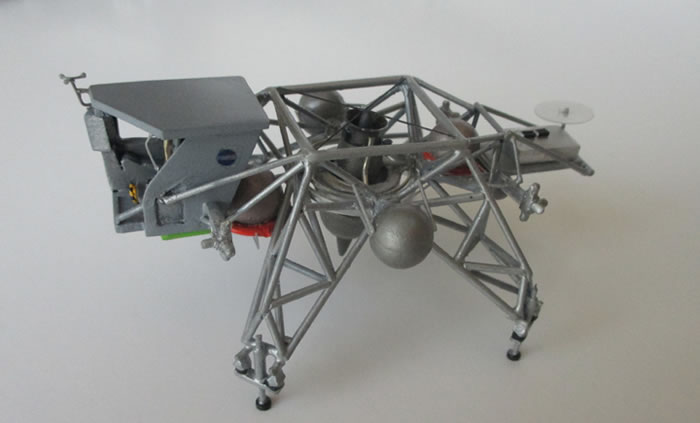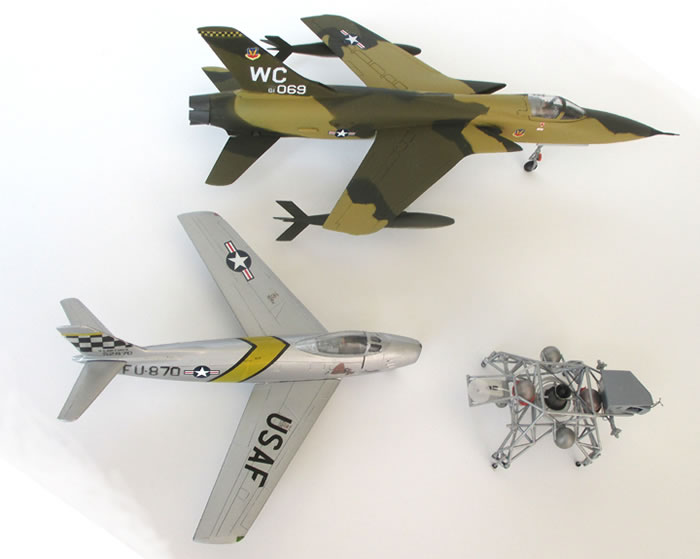Aldrin’s F-86, Armstrong’s LLRV, and Collins' F-105D in 1/72 scale
My Tribute for the 50th Anniversary of Apollo 11
by Tom Conte
|

|
Apollo 11 Tribute |

Tamiya's 1/32 scale P-51D Mustang is available online from Squadron.com for just $146.99!
My tribute to remembering the events of 50 years ago was to do the same thing I was doing when men first landed on the Moon, build models. I built the Revell 1/144 scale Saturn V doing the mission, this time I wanted something different.
Before they were Astronauts, the three crew members were pilots and aviators, so I started researching into what they flew. All were military pilots and all flew the current aircraft of the time. For Buzz Aldrin I decided to model a F-86 Sabre. He was an Airforce pilot during the Korean War and is credited with three Migs. He posed in a F-86E to celebrate one his victories and that’s the particular aircraft I built. I started with a Matchbox Sabre because it had the older style canopy. The model needed a little nose job and the stabilizer attachment point had to be modified to convert it to the flying tail style that was introduced on the later version of the F-86 that he flew. The decal showing a dog chasing a Mig on the aircraft was created from an online image that was modified by compensating for the angle of the photo and the missing parts filled in on the computer and printed out. Other decals came for the spare box to represent the squadron he flew with. It took some effort to match the time periods for the proper 56th squadrons markings and I pretty sure that the checked tail is appropriate. You have to love the internet for attracting comments because a viewer called out that the photo op F-86 wasn’t his regular mount and listed the serials numbers, thanks.

Neil Armstrong was a Navy aviator that flew just about everything from sailplanes to Xplanes, he was also active in model aviation. With so many choices, I went with scratchbuilding a very unique aircraft, the Lunar Landing Research Vehicle, specifically the one he crashed while preparing to fly the Lunar Module for his ride to the Moon. Besides being one of a kind and contributing to the understanding how something would fly in airless space, the LLRV was the first flying machine to totally depend on the use of fly-by-wire, this effort is one of the things that came out of the space program, nobody could have predicted that most future aircraft would be using this system. The engineers just could not find a method to use traditional flight controls so from zero they came up with the LLRV electronic/computer flight system. That design feature created a minor issue for me because the box containing the computer was constantly changing shape and its position on LLRV also shifted around. The LLRV was built before designs for the LM was finalized and was constantly being modified when better ideas on how flight controls should performed were discovered. This made building the model very tough to finish because when using the published NASA drawings and dimensions, sub-assemblies I built would not come together properly. It took really diving deep into the written reports to discover that about 14 inches were cut from the front of the cabin when the controls were changed from a helicopter configuration to the final flight control layout that was copied and used in the LM. Fixtures were created to assemble the four frame legs and to bring them together. The thrusters were made from a casting after creating a master. Thin wire beside many small diameters of plastic rod was used in it construction. It was painted in a number different of Floquil silver paints with some color added to highlight the round fuel tanks. The cabin is gray painted plastic sheet stock with the ejection seat also being scratchbuilt, the black and yellow pull cord that Neil used being highly visible right in the front. It took two starts on the cabin before the dimension discrepancies were discovered and a third cabin finally built.

Michael Collins was an Airforce pilot that didn’t have any outstanding aerial victories or experimental aircraft to fly like his buddies. What he did do well was command a Field Training Detachment that developed the maintenance procedures when new aircraft were introduced that trained both pilots and mechanics and he was at Nellis AFB when the Republic F-105D arrived. In his book, he mentioned this and while he also says it was a tedious job however it did allowed him to acquire the flight time he required to apply for the astronaut position. Beside I worked at Republic and needed a F-105 for my collection. I built a F-105D that was the first to be used in weapon testing at Nellis during the early 60’s. It started out as the old Hasagawa F-105B kit but with a nose job and other changes, I made it a D model. I was tired of making silver aircraft so the camouflage was another reason I choose it. The model was painted in Model Master’s colors and again the decals were scrounged from the never throw away box. Since I can’t print white decals I had to go with what was commercially available so the tail markings are a little off.

Building models uses many skills and one I needed a little help with was the creation on the dog chasing the Mig decal. I knew that the image was distorted but by how much? A discussion with my Son, a math major resulted in solving the problem, it only took him seconds to calculate the percentage that the image was foreshorten and once scanned into Photoshop, I was able to stretch the image to the proper length. Who said that you will never use what you learn in school. He also met Dr. Aldrin and I have a wonderful video of Aldrin taking time out of a meet and greet with hundreds of adults waiting to shake his hand but stopping to answer at the time my 5 year old Son’s questions and sign one of his books.
I have many Apollo spacecraft models that I expect to take the time and build later so the aircraft was my quick tribute for the 50th anniversary of Mankind’s historical event that I remember like yesterday. I can’t believe it’s that long ago.
Tom Conte
Model and Text Copyright ©
2019 by Tom Conte
Page Created 17 July, 2019
Last Updated
17 July, 2019
Back to
HyperScale Main Page

|
Home
| What's New |
Features |
Gallery |
Reviews |
Reference |
Forum |
Search